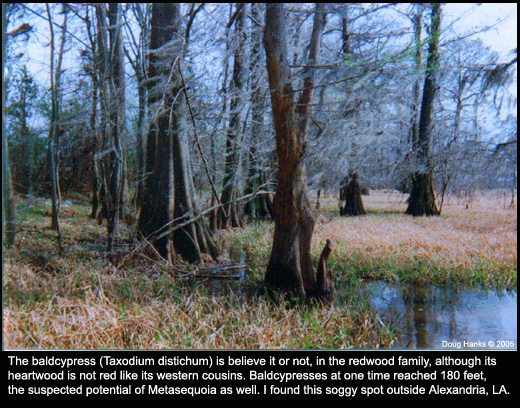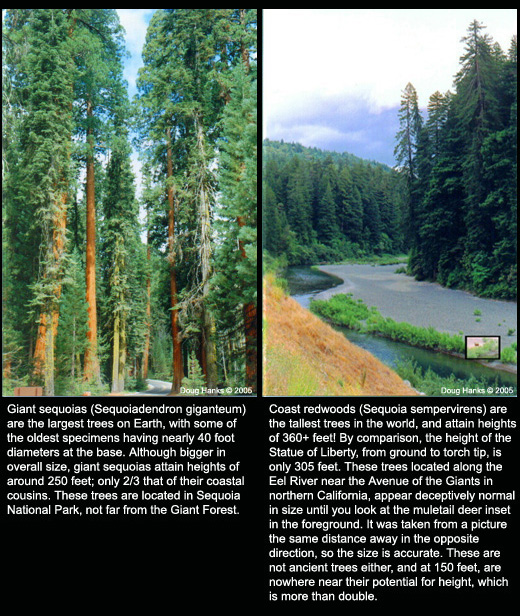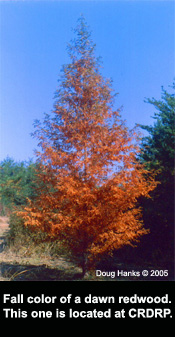|
One of the founding objectives of CRDRP was to not only plant dawn redwoods, but to study them in a natural habitat as well. The above graph is typical of information you will find on many dawn redwood sites, but is completely inaccurate in the majority of its “facts.” I will cover each item individually, and attempt to clear up many of the dawn redwood myths that have sprung up due to misinformation.
First, let me state that the dawn redwood is
not a cultivar of baldcypress! Believe it or not, I have read this claim in an encyclopedia: “Dawn redwood- A baldcypress with…” Dawn redwoods and baldcypresses, along with coastal and Sierra redwoods and many other species - a total of ten in all - are all members of the Redwood family, or
Taxodiaceae.
Like the baldcypress, the dawn redwood is a deciduous conifer; that is, it sheds its needles for the winter months, just as a larch does. Interestingly, all three of the aforementioned deciduous conifers are also regenerative; in the fact that if cut down, they will not die like a spruce or hemlock would, but will grow new leaders.
Since they shed their needles in the fall, many homeowners who have recently purchased a property on which a dawn redwood grows, have mistakenly cut the tree down over the winter months thinking it was dead. In the spring, the “dead” dawn redwood begins sending new leaders skyward from the stump of the cut-down tree, much to the amazement of the homeowners who never make the same mistake twice.
In regard to the above graph, let’s start at the top and work down:
Mature Height: 50-90 feet.
This is in fact, false. Many dawn redwoods in this country that are less than fifty years old have already surpassed the 100-foot mark. Original shrine trees in China range from 115 - almost 130 feet tall and even taller specimens have been reported, soaring to over 160 feet! This is 2-3 times taller than the commonly-accepted height.
Mature spread: 15-25 feet:
False. As they age, metasequoias generally lose their conical shape and take on a rounded, and somewhat spreading, crown. The Type tree in Moudao, Lichuan, Hubei, China, has a spread of approximately 100 feet! Keep in mind that there are different cultivars however; the tall tree in Lubeiba, Xiaohe, Lichuan, Hubei, although towering at approximately 130 feet, retains a densely pyramidal shape with a spread of around forty-five feet near the base.
Mature form: Pyramidal. Once again, the “facts” seem to revolve around the observations of a few fifty-year-old trees in this country. Although a few ancient trees in China remain pyramidal in form, most - along with the aging specimens in the US - tend to take on a spreading shape, very much like the ancient baldcypresses in this country.
Growth rate: Rapid. I agree. I have had certain metasequoias on the Preserve go from four to twenty feet in only three growing seasons! Optimal growth seems to be at a rate of up to seven feet per year; phenomenal!
Sun exposure: Full sun. Metasequoias love full sun and an abundance of groundwater in deep, well-drained, acidic soil. There are three factors that allow Metasequoia to grow, and it only needs two of the three to survive. These are: Full sun, water, and acidic, well-drained soil. If you somehow manage to combine all three, you will end up with trees that not only thrive, but if left branched to the ground, will give the grotesquely-based trees that have made the specie famous.
Soil moisture and soil type: Widely adaptable. This is
true; however, like the baldcypress; Metasequoia is capable of surviving in dry soils, although not to the best of its ability. Dawn redwood’s preferred soil is very acidic, with a pH of 4.5 being ideal (as is the case with all American redwood species). To give you an idea of just how acidic this is, vinegar is 4, lemon juice is 3, and battery acid is 1. Normal pH is a neutral of 7. This suggests that dawn redwoods would be ideal for reforestation in areas such as Quebec, where acid rain has decimated local species. Additionally, Metasequoias love full sun and an abundance of groundwater.
Flower color: Not showy. This is
true, in that Metasequoia is monoaceous, in that it has both male and female cones on the same tree. The male cones, or strobili, resemble green pearls and attract no special attention.
Foliage color: Green. This is perhaps the only description of Metasequoia that has no argument. Chlorophyll turns the leaves (needles) green during the summer months, and the lacey foliage is almost fernlike in its appearance.
Fall color: Orange and
yellow. Not too far off; Metasequoia changes from spring green to an almost apricot color after the first frost. At CRDRP, the pinkish/orange foliage of the dawn redwoods stands out in stark contrast to the surrounding Virginia pine.
Zones: 4-8. This is indeed,
accurate. Dawn redwoods love moist weather within that zone range. This explains Metasequoia’s phenomenal growth rate in the eastern and southern US. In Sichuan and Hubei, the habitat is actually a Zone 9; much hotter and drier during the summer months than the tree truly favors. It is my personal belief that by naturalizing Metasequoia into its ideal habitat, that the tree will one day enjoy a status that supercedes its Chinese brethren.
At CRDRP, yearly rainfall equals - if not surpasses - Sichuan, and the temperatures are much more favorable for Metasequoia. Additionally, naturally acidic soils salted with sulfur to become increasingly acidic, and an iron-rich, water-laden substrata, lend to the most ideal growing conditions in the world.
My observations thus far in this experiment:
1) Metasequoia does not like to be crowded; in fact, when a dawn redwood grows in close proximity to another tree, it will do one of two things, depending on conditions: First, it has the propensity to simply die. Secondly it may grow, but very slowly and virtually devoid of any branches or foliage on the shady side.
2) Metasequoia needs two of three conditions to survive:
Sun, moisture, and soil acidity. Any combination of two will ensure survival, but all three will ensure spectacular results!
3) Bare root specimens are extremely hardy, but Jiffy pot trees need to be raised in planters prior to planting. I planted a few dozen bare root trees in 1998 during La Nina (drought) and all not only survived, but are excelling. Similarly, Jiffy pot trees due to a limited root system, tend to die when planted in the wild. They are not hardy enough to withstand winter temperatures or any semblance of drought.
4) Dual-trunked trees tend to absorb the secondary trunk. Dawn redwoods that start out as impressive dual-trunked trees seem to absorb the shorter of the two trunks and turn it into a cantilevered branch. The only dual or multi-trunked dawn redwoods seem to be those that have been severely damaged well into their lifetimes.
5) Dawn redwoods will grow in standing water. Like the baldcypress, the dawn redwood will grow in standing water. I planted Metasequoia in swampy locations, and a few on the bank of and some actually in, the creek. All are doing very well.
These are but a few of the many metasequoia facts out there, and more are being discovered every day. While not meant to be a complete overview of the project, I hope this information is of interest to the observer.
Metasequoia's Cousins


|



